The success story of Singapore’s transformation from Third World to First World paints a picture of immense changes.
In the post-independence era, Singapore’s social landscape has been shaped by many defining campaigns. While these government-led national campaigns have social engineered many changes, there are continuities that can be traced to the past.
These old campaigns remain relevant to current events, and some have effects that still persist today. Additionally, some have also developed and evolved to become the current campaigns that we are familiar with.
Speak Mandarin Campaign
The bilingual policy was crucial to the formation of the Singaporean identity. English was chosen by the government as the first language because it was race-neutral and also the language of business and technology. The second language would be an individual's mother tongue, serving to strengthen one’s values and sense of cultural belonging.
The use of Chinese dialects was seen as hampering the implementation of the bilingual policy. Thus, Mandarin was designated as the mother tongue for all Singaporean Chinese in the 1970s.
The Speak Mandarin Campaign was implemented in 1979, and by the late 1980s, the majority of Chinese Singaporeans spoke Mandarin instead of dialects.
This campaign is still ongoing today. Here are some posters from the 1980s:
 Photo from NAS
Photo from NAS
Mandarin is touted to be “in” while dialects are “out”.
 Photo from NAS
Photo from NAS
Mandarin was also promoted to be “convenient for everybody” because it served as a common language for Chinese Singaporeans to communicate.
In a somewhat ironic twist of events, the importance of dialects has been revived in recent years. A ground up campaign by university students called "My Father Tongue" has been launched in 2016. It encourages young people to pick up dialects so they can communicate with older people.
And in another sign of changing times, we see, probably for the first time since the 1970s, a government-funded local Chinese dialect drama being aired on TV in September last year.
"Stop at two" campaign
In 1966, KK Hospital earned a Guinness World Record for the largest number of births in a single maternity facility -- a record it held for 10 years.
Up to the 1970s, most people planned for large families with at least three children.
However, given concerns in managing issues arising from economic development and the provision of welfare services to the people in the early years of independence, there was a National Family Planning Campaign to curb fertility rates and promote desirability of small families.
It was commonly known as the "Stop at two" campaign, and it was targeted mainly at lesser educated and lower income groups, encouraging them to have only two children so as to give them better opportunities in life.
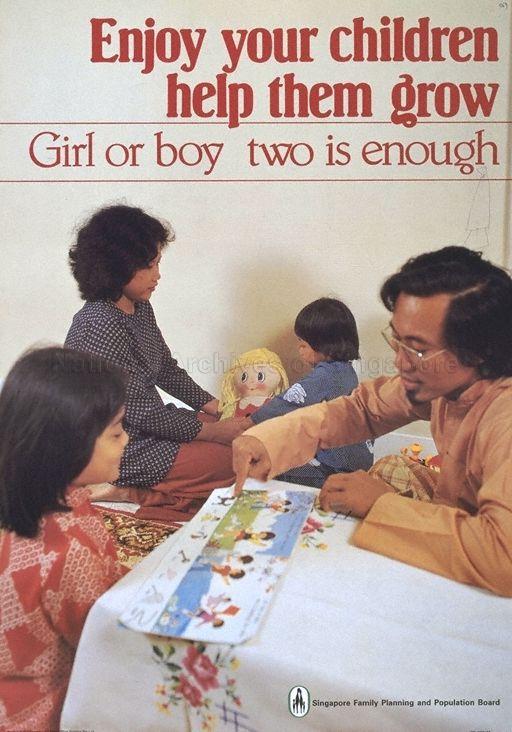 Photo from NAS
Photo from NAS
Campaign posters often featured girls. This was to encourage people to stop at two regardless of the child's gender.
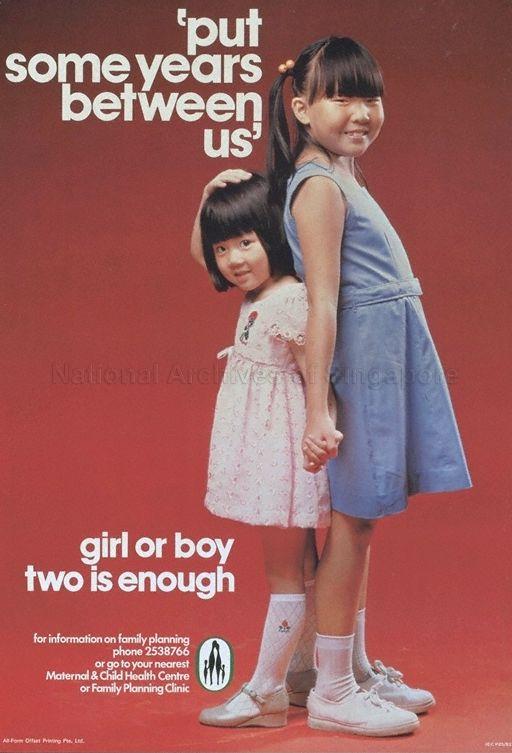 Photo from NAS
Photo from NAS
By the 1980s, the fertility rate had become a cause for concern. It was projected that there would be a heavy burden on the workforce to support the ageing population.
In 1987, the government implemented measures and incentives encouraging parents to have three or more children if they could afford it.
Despite the incentives, low birth rates still persist as a problem today. Mitigating the effects of the "Stop at two" campaign still remains a challenge.
National Courtesy Campaign
The Courtesy Campaign began as an initiative by the Singapore Tourist Promotion Board (now known as Singapore Tourism Board) in the late 1970s to encourage Singaporeans to be more polite and friendly to tourists.
However, then-Prime Minister Lee Kuan Yew strongly felt that the campaign should encourage Singaporeans to be polite to everybody and not only to tourists in order to create a pleasant social environment.
Thus, the courtesy campaign was launched in 1979 to raise people’s awareness of the need to be courteous and considerate in social situations.
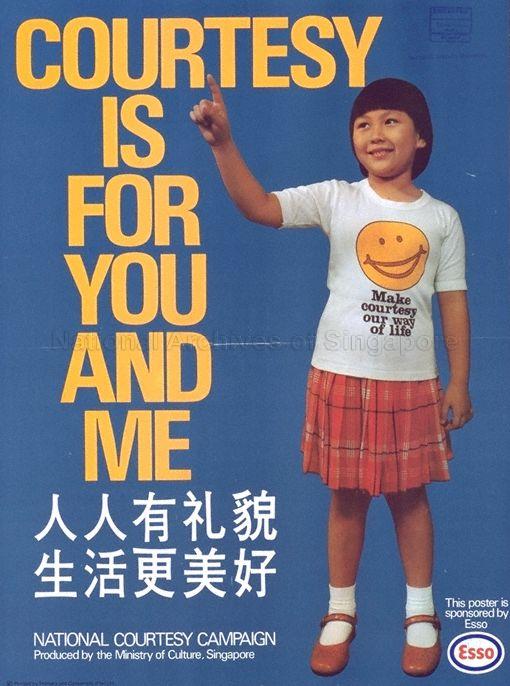 Photo from NAS
Photo from NAS
The courtesy campaign logo originally involved a smiley face.
 Photo from NAS
Photo from NAS
If this creepy smiley logo seems unfamiliar, perhaps you’d recall Singa the lion mascot.
The organisers replaced the smiley head with Singa when they felt the message of the campaign seemed like it was only about smiling.
In 2013, Singa the lion resigned. He wrote a letter of resignation stating that he is "too tired to continue facing an increasingly angry and disagreeable society". He added that "not many of us believe in or care about expressing kindness. This move has provoked mixed reactions from people.
The courtesy campaigns of today are subsumed under what we know as the Singapore Kindness Movement (SKM).
National productivity campaigns
In order to meet the challenges of a competitive global economic environment, the National Productivity Council and the Productivity Movement were launched in 1981 to improve the quality of the workforce by instilling a culture of productivity.
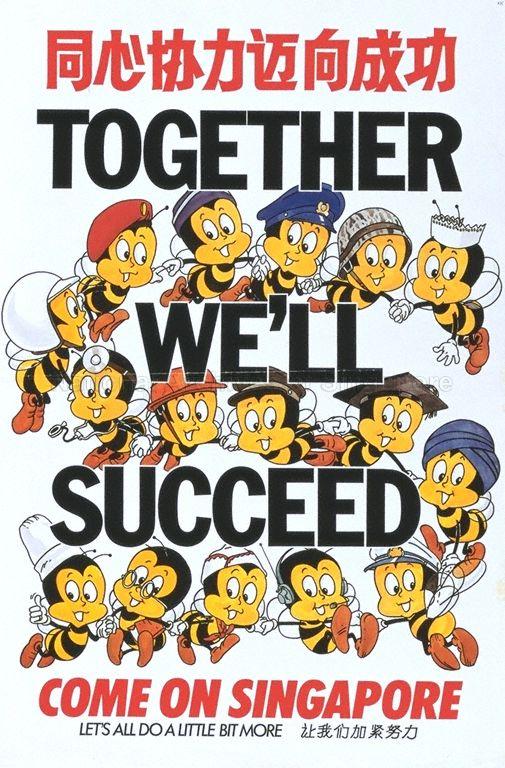 Photo from NAS
Photo from NAS
Teamy the bee was the mascot for productivity campaigns, revolving around industriousness regardless of job scope. Different job roles are suggested in this poster such as a doctor, policeman and soldier.
There was also a focus on skills and quality of the workforce by encouraging training.
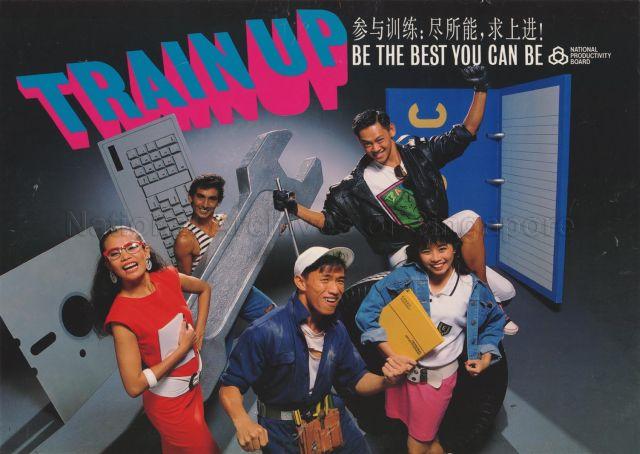 Photo from NAS
Photo from NAS
Teamy retired in 1999, but productivity campaigns continued in the 2000s under the Singapore Productivity and Standards Board (PSB).
 Photo from NAS
Photo from NAS
This poster from the 2000s shows the importance of thinking out of the box to solve problems.
Rapid technological developments and strong global competition for jobs continue in the 21st century.
Recent campaigns exemplify the same spirit of past productivity campaigns by adopting the skills-based approach to productivity and promoting creative problem-solving.
Some recent campaigns include We Are InDIYpendent and Skillsfuture. In 2015, the We Are InDIYpendent campaign encouraged businesses to adopt self-service models to facilitate operations processes. In 2016, Skillsfuture was launched to emphasize the value of acquiring deep skills besides academic qualifications, which will help to enhance one's employability in the future economy.
Change and continuity
As we move into the future, change is indeed the only constant. Amid the transformation and adjustments we make, it is important to remember that history informs the present and we are never too disconnected from our past.
Top image from NAS
If you like what you read, follow us on Facebook and Twitter to get the latest updates.
If you like what you read, follow us on Facebook, Instagram, Twitter and Telegram to get the latest updates.